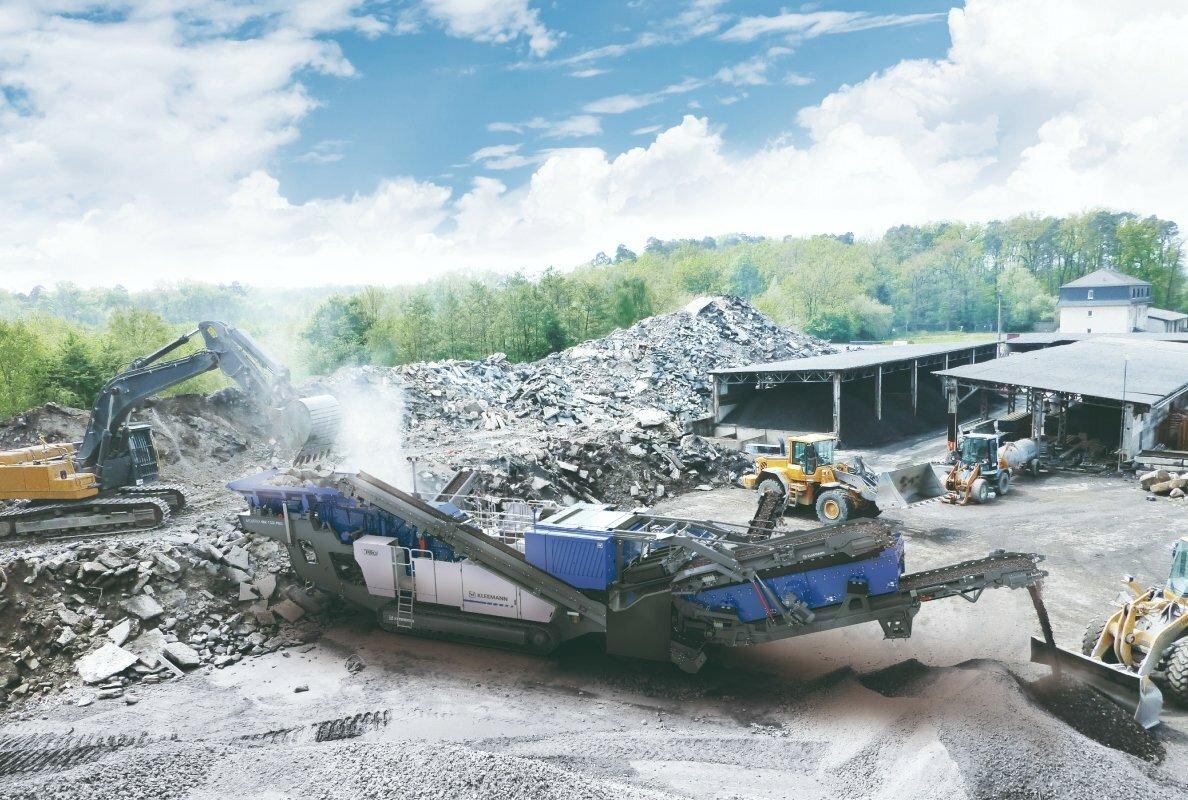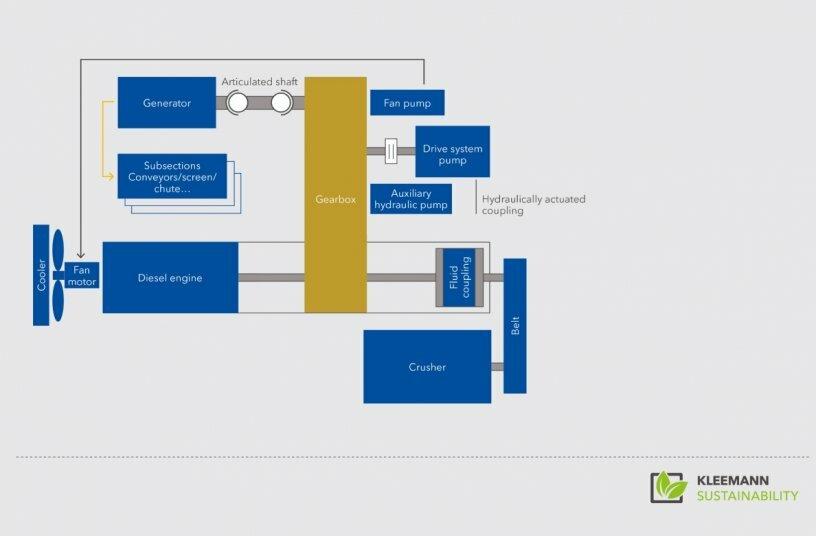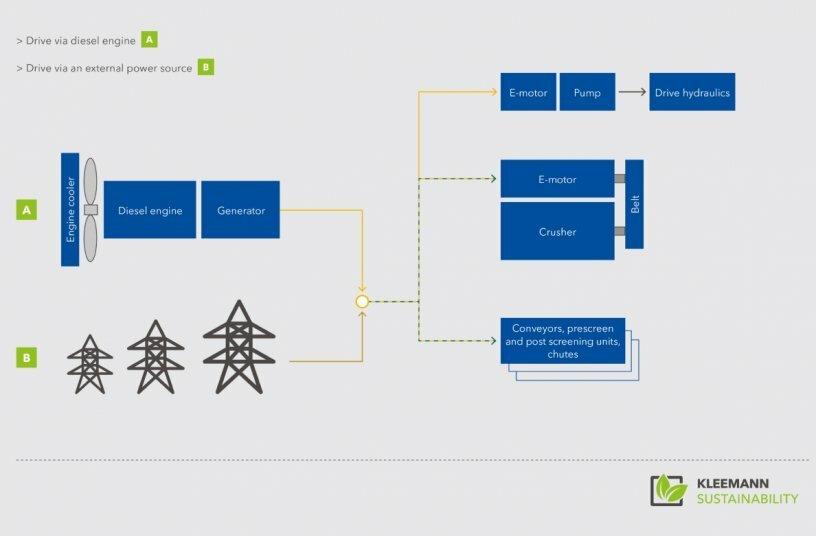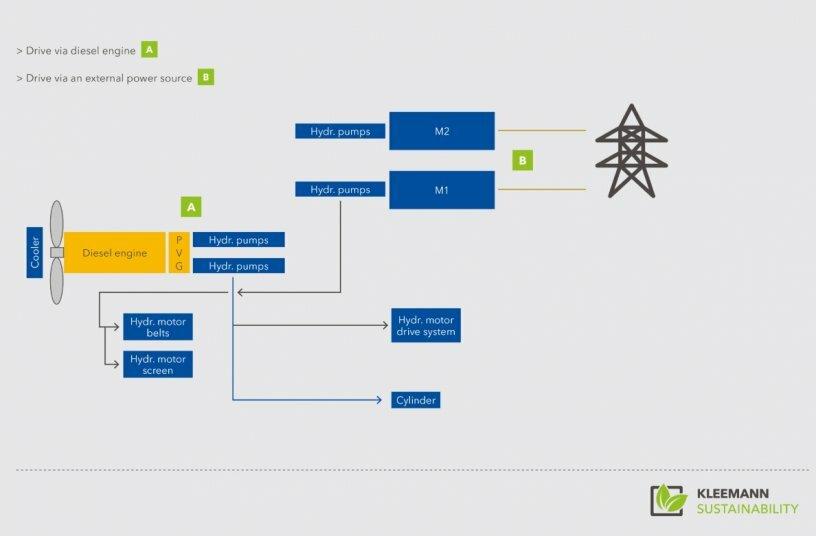Sustainable Drive Concepts for every Requirement
 12/07/23-FR-English-NL-footer
12/07/23-FR-English-NL-footer
Des concepts d'entraînement durables pour chaque exigence
 In stationary recycling operations, the preconditions for the use of a Kleemann crushing plant with E-DRIVE are often very favourable. An adequate power supply is often available, occasionally even from an in-company photovoltaic system. IMAGE SOURCE: Kleemann
In stationary recycling operations, the preconditions for the use of a Kleemann crushing plant with E-DRIVE are often very favourable. An adequate power supply is often available, occasionally even from an in-company photovoltaic system. IMAGE SOURCE: Kleemann


 Trois solutions pour un fonctionnement respectueux de l'environnement. Un aperçu des concepts et des options d'application
Trois solutions pour un fonctionnement respectueux de l'environnement. Un aperçu des concepts et des options d'application
Kleemann utilise trois concepts d'entraînement différents qui offrent la meilleure solution possible en fonction des tâches à accomplir. Bien que les entraînements électriques obtiennent de très bons résultats en ce qui concerne l'empreinte carbone, dans certaines situations, un entraînement direct économe en carburant est la meilleure solution. E-DRIVE, D-DRIVE et H-DRIVE représentent les variantes diesel-électrique, diesel-direct et diesel-hydraulique.
Le choix de la solution la plus efficace dépend de nombreux facteurs : par exemple, s'il existe une option d'alimentation électrique disponible sur site, si les machines sont utilisées dans un environnement urbain ou quelles réglementations environnementales locales s'appliquent.
E-DRIVE – sans émission grâce à la propulsion électrique
Le concept E-DRIVE propose deux options : Diesel ou tout électrique. Le fonctionnement tout électrique est respectueux de l'environnement : il n'y a pas d'émission de CO2 sur place. Une condition préalable à cela est une bonne infrastructure électrique, qui est souvent disponible dans les carrières ou dans les grands chantiers de recyclage. Si l'alimentation électrique est insuffisante ou inexistante, une option de travail diesel-électrique est disponible. Par exemple, si l'installation complète de la carrière doit être déplacée le long de la paroi rocheuse. L'alimentation est alors assurée par un câble long, souvent trop complexe voire plus possible. Dans ce cas, la puissance provient du moteur diesel économe en carburant. Le broyeur et toutes les bandes transporteuses sont alors toujours entraînés électriquement par un générateur. En fonction de la situation locale, le concept E-DRIVE offre une grande flexibilité.
Les installations de la gamme PRO, telles que le MOBICAT MC 120(i) PRO, peuvent fonctionner entièrement à l'électricité ou, en alternative, avec un moteur diesel. Le broyeur et toutes les bandes transporteuses sont alors toujours entraînés électriquement par un générateur.
Le D-DRIVE à entraînement direct diesel fournit la puissance directement du moteur au concasseur. Au cours des dernières années, il a été possible de réduire la consommation, par exemple grâce à l'entraînement du ventilateur en fonction de la charge de la nouvelle génération EVO2. En ce qui concerne le degré d'efficacité, le diesel à entraînement direct a l'avantage et la consommation de carburant est nettement inférieure. Grâce à leur taille compacte et à des options de transport bien pensées, les machines peuvent être positionnées n'importe où sur le chantier. Si l'utilisation continue de l'entraînement tout électrique n'est pas possible, le D-DRIVE est le meilleur choix, le plus durable, chaque fois que la flexibilité est requise. C'est le cas des travaux de démolition et de transformation en milieu urbain, mais aussi de la construction de routes où les engins doivent être déplacés au fur et à mesure de l'avancement des travaux.
Concasseur à entraînement direct D-DRIVE sur les installations de concassage EVO2 de Kleemann : Le coupleur hydraulique garantit une sécurité de fonctionnement élevée - pour l'opérateur et la machine. Tous les entraînements secondaires, tels que le précrible, les goulottes ou les bandes transporteuses, sont entraînés électriquement.
Les installations de criblage de Kleemann utilisent un entraînement diesel-hydraulique efficace. Dans ce cas, les pompes hydrauliques font fonctionner toutes les pièces de la machine telles que le crible, les courroies et le système d'entraînement. Les besoins en énergie des cribles sont considérablement inférieurs à ceux d'un concasseur - la consommation de carburant pendant le fonctionnement est donc plus favorable. Le système Start-Stop disponible en option permet de réduire encore plus la consommation. Avec la configuration avec Dual Power, les installations de criblage Kleemann ont la possibilité d'une alimentation électrique tout électrique. Si un raccordement au secteur est disponible, l'installation fonctionne sur un site exempt d'émissions, par exemple dans des zones écologiquement sensibles soumises à des réglementations strictes.
Les installations de criblage Kleemann utilisent un entraînement diesel-hydraulique efficace. De plus, la configuration avec Dual Power offre la possibilité d'une alimentation tout électrique. Si un raccordement au secteur est disponible, l'installation fonctionne sur site sans émission.
De nombreux facteurs jouent un rôle dans le domaine de la durabilité. L'énergie nécessaire à la production, au transport, au stockage, à la vente et à l'élimination est intégrée dans l'empreinte écologique du processus de production. En ce qui concerne les émissions de CO2 pendant le fonctionnement, une centrale tout électrique est sans aucun doute le meilleur choix. Dans d'autres cas, il faut se demander si l'alimentation via une source d'alimentation externe impliquant des coûts d'équipement et de matériel élevés est finalement plus constructive qu'une technologie à faible consommation de carburant. L'écologie peut également signifier faire confiance à une faible utilisation de matériaux et à une grande durabilité.
NJC.© Info Kleemann
------------------------------------------------------------------------------------------------------
 12/07/23-English
12/07/23-English
Sustainable Drive Concepts for every Requirement
 In stationary recycling operations, the preconditions for the use of a Kleemann crushing plant with E-DRIVE are often very favourable. An adequate power supply is often available, occasionally even from an in-company photovoltaic system. IMAGE SOURCE: Kleemann
In stationary recycling operations, the preconditions for the use of a Kleemann crushing plant with E-DRIVE are often very favourable. An adequate power supply is often available, occasionally even from an in-company photovoltaic system. IMAGE SOURCE: Kleemann


 Three solutions for environmentally friendly operation. An overview of concepts and application options
Three solutions for environmentally friendly operation. An overview of concepts and application options
Kleemann uses three different drive concepts that offer the best possible solution depending on the tasks at hand. Although electric drives score very well with regard to the CO2 footprint, in some situations a fuel-saving directdrive is the better solution. E-DRIVE, D-DRIVE and H-DRIVE represent the variants diesel-electric, diesel-direct and diesel-hydraulic.
The decision on the most efficient solution depends on many factors: For example, if there is a power supply option available on site, whether the machines are used in an urban environment or which local environmental regulations apply.
E-DRIVE – emission-free thanks to electric drive
The E-DRIVE concept offers two options: Diesel fuel or all-electric. All-electric operation is environmentally friendly: there are no CO2 emissions on site. A precondition for this is a good power infrastructure, which is often available in quarries or in larger recycling yards. In the power supply is insufficient or there isn’t one available, a diesel-electric work option is available. For example, if the complete plant in the quarry is to be moved along the rock face. Power is then supplied from a long cable, which is often too complex or even no longer possible. In this case, power comes from the fuel-efficient diesel engine. The crusher and all conveyor belts are then still driven electrically by a generator. Depending on the local situation, the E-DRIVE concept offers high flexibility.
Plants in the PRO line, such as the MOBICAT MC 120(i) PRO, can be operated completely with electricity or, alternatively with a diesel engine. The crusher and all conveyor belts are then still driven electrically by a generator.
The diesel-directdrive D-DRIVE provides power directly from the engine to the crusher. In the last few years, it was possible to reduce consumption, for example, through the load-dependent fan drive of the new EVO2 Generation. With regard to the degree of efficiency, the diesel-directdrive has the edge and fuel consumption is significantly lower. Thanks to their compact size and well thought-out transport options, the machines can be positioned in any place on the work site. If continuous use of the all-electric drive is not possible, the D-DRIVE is the better, more sustainable choice – whenever flexibility is required. This is the case with demolition and processing work in urban areas, but also in road construction where the machines have to be moved along as construction progresses.
Crusher directdrive D-DRIVE on the EVO2 crushing plants from Kleemann: The fluid coupling guarantees high operational safety – for operator and machine. All secondary drives, such as prescreen, chutes or conveyor belts, are driven electrically.
The screening plants from Kleemann use an effective diesel-hydraulic drive. In this case, hydraulic pumps operate all machine parts such as screen, belts and drive system. The power requirements of the screens are considerably lower than a crusher – fuel consumption during operation is therefore more favourable. The optionally available Start-Stop system can reduce consumption even more. With the configuration with Dual Power, Kleemann screening plants have an option for an all-electric power supply. If a mains connection is available, the plant operates on site free of emissions – for example, in ecologically sensitive areas with strict regulations.
The Kleemann screening plants use an effective diesel-hydraulic drive. Furthermore, the configuration with Dual Power provides an option for an all-electric power supply. If a mains connection is available, the plant operates on site free of emissions.
Many factors play a role in the area of sustainability. Energy required for production, transport, storage, sales and disposal are all incorporated in the ecological footprint of the production process. As far as CO2 emissions during operation are concerned, an all-electric plant is without doubt the best choice. In other cases, you have to weigh up whether supply via an external power source involving high equipment and material costs is more constructive at the end of the day than technology with lower fuel consumption. Ecology can also mean placing your trust in low material usage and high durability.
NJC.© Info Kleemann
--------------------------------------------------------------------------------------------------------------------
 12/07/23-NL
12/07/23-NL
Duurzame aandrijfconcepten voor elke eis
 In stationary recycling operations, the preconditions for the use of a Kleemann crushing plant with E-DRIVE are often very favourable. An adequate power supply is often available, occasionally even from an in-company photovoltaic system. IMAGE SOURCE: Kleemann
In stationary recycling operations, the preconditions for the use of a Kleemann crushing plant with E-DRIVE are often very favourable. An adequate power supply is often available, occasionally even from an in-company photovoltaic system. IMAGE SOURCE: Kleemann


 Drie oplossingen voor milieuvriendelijk werken. Een overzicht van concepten en toepassingsmogelijkheden
Drie oplossingen voor milieuvriendelijk werken. Een overzicht van concepten en toepassingsmogelijkheden
Kleemann gebruikt drie verschillende aandrijfconcepten die de best mogelijke oplossing bieden, afhankelijk van de uit te voeren taken. Hoewel elektrische aandrijvingen erg goed scoren wat betreft de CO2-footprint, is in sommige situaties een brandstofbesparende directdrive de betere oplossing. E-DRIVE, D-DRIVE en H-DRIVE vertegenwoordigen de varianten dieselelektrisch, dieseldirect en dieselhydraulisch.
De beslissing over de meest efficiënte oplossing hangt van veel factoren af: bijvoorbeeld of er ter plaatse een stroomvoorziening beschikbaar is, of de machines in een stedelijke omgeving worden gebruikt of welke lokale milieuvoorschriften van toepassing zijn.
E-DRIVE – emissievrij dankzij elektrische aandrijving
Het E-DRIVE-concept biedt twee opties: diesel of volledig elektrisch. Volledig elektrisch rijden is milieuvriendelijk: ter plaatse is er geen CO2-uitstoot. Voorwaarde hiervoor is een goede stroominfrastructuur, die vaak aanwezig is in steengroeven of op grotere recyclingterreinen. Is de stroomvoorziening onvoldoende of niet aanwezig, een dieselelektrische werkoptie is leverbaar. Bijvoorbeeld als de complete installatie in de groeve langs de rotswand moet worden verplaatst. Stroom komt dan uit een lange kabel, wat vaak te ingewikkeld of zelfs niet meer mogelijk is. In dit geval komt het vermogen van de zuinige dieselmotor. De breker en alle transportbanden worden dan nog elektrisch aangedreven door een generator. Afhankelijk van de lokale situatie biedt het E-DRIVE-concept een hoge mate van flexibiliteit.
Installaties uit de PRO-lijn, zoals de MOBICAT MC 120(i) PRO, kunnen volledig op elektriciteit of als alternatief op diesel worden aangedreven. De breker en alle transportbanden worden dan nog elektrisch aangedreven door een generator.
De D-DRIVE met directe dieselaandrijving levert rechtstreeks vermogen van de motor aan de breker. De afgelopen jaren was het bijvoorbeeld mogelijk om het verbruik te verminderen door de lastafhankelijke ventilatoraandrijving van de nieuwe EVO2-generatie. Qua efficiëntie heeft de diesel-directdrive een streepje voor en ligt het brandstofverbruik beduidend lager. Dankzij hun compacte formaat en doordachte transportmogelijkheden kunnen de machines op elke plek op de werkplek worden geplaatst. Als continu gebruik van de volledig elektrische aandrijving niet mogelijk is, is de D-DRIVE de betere, duurzamere keuze - wanneer flexibiliteit vereist is. Dit is het geval bij sloop- en verwerkingswerkzaamheden in stedelijk gebied, maar ook in de wegenbouw waar de machines tijdens de bouw moeten worden verplaatst.
Crusher directdrive D-DRIVE op de EVO2-breekinstallaties van Kleemann: de vloeistofkoppeling garandeert een hoge bedrijfszekerheid – voor operator en machine. Alle secundaire aandrijvingen, zoals voorzeef, stortkokers of transportbanden, worden elektrisch aangedreven.
De zeefinstallaties van Kleemann maken gebruik van een effectieve dieselhydraulische aandrijving. In dit geval bedienen hydraulische pompen alle machineonderdelen zoals scherm, riemen en aandrijfsysteem. De vermogensbehoefte van de zeef is aanzienlijk lager dan die van een breker – het brandstofverbruik tijdens bedrijf is daardoor gunstiger. Het optioneel verkrijgbare Start-Stop-systeem kan het verbruik nog verder verminderen. Met de configuratie met Dual Power hebben zeefinstallaties van Kleemann een optie voor een volledig elektrische voeding. Als er een netaansluiting beschikbaar is, werkt de installatie ter plaatse emissievrij – bijvoorbeeld in ecologisch kwetsbare gebieden met strikte regelgeving.
De zeefinstallaties van Kleemann maken gebruik van een effectieve dieselhydraulische aandrijving. Bovendien biedt de configuratie met Dual Power een optie voor een volledig elektrische voeding. Als er een netaansluiting beschikbaar is, werkt de installatie ter plaatse emissievrij.
Op het gebied van duurzaamheid spelen veel factoren een rol. De energie die nodig is voor productie, transport, opslag, verkoop en verwijdering zijn allemaal verwerkt in de ecologische voetafdruk van het productieproces. Wat de CO2-uitstoot tijdens bedrijf betreft, is een volledig elektrische centrale zonder twijfel de beste keuze. In andere gevallen moet je afwegen of voeding via een externe stroombron met hoge apparatuur- en materiaalkosten uiteindelijk constructiever is dan technologie met een lager brandstofverbruik. Ecologie kan ook betekenen dat u vertrouwt op laag materiaalgebruik en hoge duurzaamheid.
NJC.© Info Kleemann
------------------------------------------------------------------------------------------------------------------
Date de dernière mise à jour : 11/07/2023
















